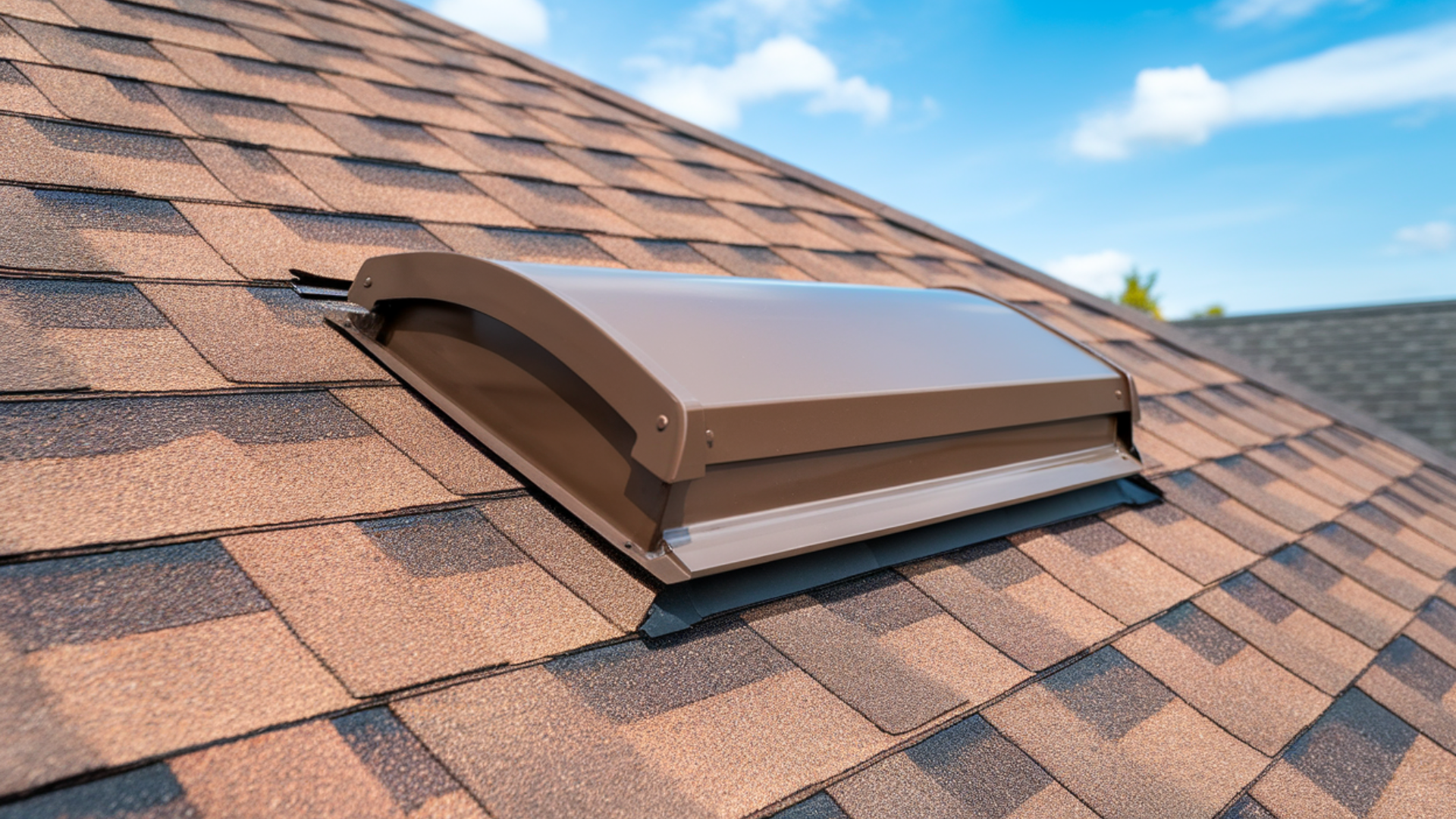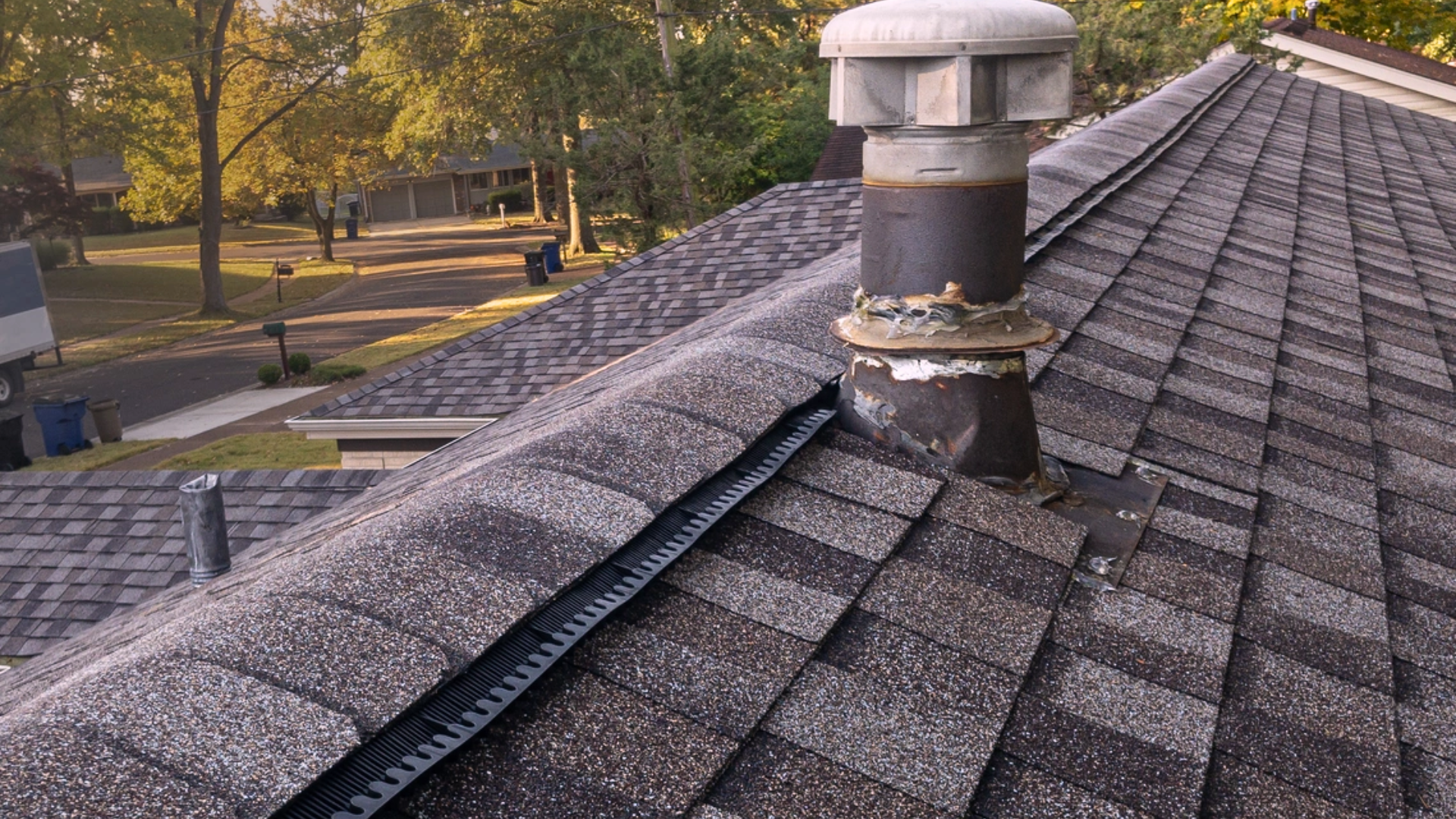Your roof’s ridge vent is essential for attic ventilation, allowing hot air and moisture to escape. Installed along the peak of the roof, it works with soffit vents to keep air flowing.
This system helped prevent heat buildup and moisture in my own home, thereby avoiding problems such as mold or wood rot.
However, small issues with your ridge vent, like leaks or blockages, can escalate and damage your roof.
In this article, I’ll cover common ridge vent problems, how to spot them, and how to fix them. Let’s get started!
Understanding Ridge Vents
Ridge vents are a crucial part of your roof’s ventilation system, allowing hot, humid air to escape from your attic and keeping your home cooler.
Installed along the peak of your roof, they work with soffit vents to create proper airflow, helping prevent issues like mold and wood rot.
Unlike older box or gable vents, ridge vents offer more consistent airflow without disrupting the look of your roof.
With a ridge vent, you provide a simple and effective way to keep your attic dry and your home energy efficient.
Common Ridge Vent Problems and Their Solutions

Ridge vents are crucial for maintaining proper airflow. However, over time, they can develop problems that affect their performance. Let’s take a look at some typical ridge vent problems and how to solve them easily.
1. Improper Installation
Improper installation of a ridge vent can cause several issues. If the vent isn’t correctly aligned or sealed, air won’t flow properly, and moisture may leak into your attic.
This can lead to a buildup of heat, humidity, and even water damage, which affects the overall health of your home.
Over time, misaligned vents can also result in costly repairs and worsen energy efficiency, as your home won’t be properly ventilated.
The Fix: Realign the vent and reseal any gaps or cracks. If unsure, have a professional reinstall it to ensure proper airflow and sealing.
2. Leaking During Heavy Rain
A common problem with ridge vents is leaking during heavy rain. This can occur when the vent’s flashing or sealant has deteriorated, allowing water to seep through the roof.
Once water enters your attic, it can damage insulation, cause mold growth, or even weaken the roof structure.
If left unchecked, this issue can lead to costly repairs and long-term damage, especially in areas prone to heavy rainfall or storms.
The Fix: Check the flashing for damage and reseal the vent with waterproof caulk. Replace any damaged areas to stop leaks from occurring.
3. Blockage from Debris or Insulation
Debris such as leaves, twigs, or even blown-in insulation can block your ridge vent, reducing airflow and leading to poor ventilation in your attic.
Without proper airflow, heat and moisture can build up, causing your attic to get excessively hot or humid.
This can negatively affect your home’s temperature, leading to higher energy bills, and can also contribute to mold or mildew growth, especially in humid climates.
The Fix: Regularly clear any debris from the vent. Install a mesh screen to prevent future blockages and ensure continuous airflow.
4. Animal or Insect Intrusion
Animals like birds, squirrels, and insects often use ridge vents as entry points into your attic. Once inside, they can cause a variety of issues, from nesting to chewing on wires.
Not only does this cause damage to the structure of your home, but it can also result in health risks, such as exposure to droppings or pests.
The small gaps in the vent can give them easy access, making it essential to keep your vent secured.
The Fix: Install a pest-proof vent cover or screen. Seal any gaps or cracks around the vent to prevent animals from entering your attic.
5. Insufficient Ventilation
If your ridge vent is not providing enough ventilation, your attic can become stuffy and excessively hot. This can increase your cooling costs and cause moisture to build up, leading to mold growth or roof damage.
Without proper airflow, your roof and attic can be at risk of deteriorating faster than usual, especially in areas with high humidity or temperatures.
Insufficient ventilation also impacts the energy efficiency of your home, making it uncomfortable to live in.
The Fix: Add more soffit vents or consider installing additional ridge vents for better airflow. Consult a professional to ensure proper ventilation balance.
6. Shingle or Roof Damage Around the Vent
Damage around the ridge vent, such as missing or cracked shingles, can lead to water infiltration.
When shingles are damaged, they no longer create a watertight seal, which allows rainwater to seep into your attic.
This can result in wet insulation, mold, and a weakened roof structure.
Over time, the damage worsens, and leaks become more frequent, causing serious structural problems that can require expensive repairs if not addressed promptly.
The Fix: Replace any damaged shingles around the vent area. Ensure proper sealing of the vent to prevent water from entering.
7. Cracked or Warped Vent Material
Ridge vents can become cracked or warped over time due to exposure to the elements, especially in areas with extreme temperatures or UV rays.
When the vent material weakens, it loses its ability to protect your attic from heat, moisture, and pests.
A damaged ridge vent can also lead to increased energy costs, as the ventilation system won’t be working properly.
In some cases, cracks can lead to leaks, which cause additional problems like water damage.
The Fix: Inspect the vent for cracks or warping. If damaged, replace the vent to maintain proper airflow and prevent further damage to the roof and attic.
The Importance of Roof Ridge Vents
Ridge vents are essential for a healthy, energy-efficient home. They keep your attic cool, dry, and well-ventilated, preventing damage and saving you money. Here’s why they matter:
1. Keeps Your Attic Cool
Ridge vents help prevent heat buildup in your attic. Without proper ventilation, your attic can get uncomfortably hot, which can affect the rest of your home’s temperature.
With ridge vents in place, hot air can escape from the attic, keeping your home cooler and more comfortable.
2. Prevents Moisture and Mold
Moisture can be a huge problem in the attic, leading to mold, mildew, and wood rot.
Ridge vents allow moist air to escape, reducing the chance of moisture buildup and preventing mold growth.
This is especially important for keeping your attic space healthy and your roof materials in good condition.
3. Extends the Life of Your Roof
A well-ventilated attic can prolong the life of your roof. Ridge vents help reduce the impact of heat and moisture on your roof’s materials.
By allowing proper airflow, they minimize the risk of damage caused by trapped heat and moisture, ultimately helping your roof last longer.
4. Improves Energy Efficiency
Ridge vents can improve your home’s energy efficiency by helping your air conditioning system run more smoothly.
When your attic stays cooler, your cooling system doesn’t have to work as hard, which can lower your energy bills over time.
Maintenance and Inspection Tips
Regular maintenance ensures your ridge vent works properly. Below are some simple tips:
- Inspect Twice a Year: Check your ridge vent in spring and fall. In spring, look for winter damage like snow or ice buildup. In fall, clear leaves and twigs before winter to prevent blockages.
- Check for Debris, Loose Shingles, Rust, or Cracks: Look for debris around the edges, loose shingles, rust, and cracks. These issues can block airflow, let water in, or damage the vent system.
- Use Binoculars or Hire a Professional: Inspect safely from the ground using binoculars. If you’re unsure or uncomfortable, hire a roofer for a thorough inspection and repair.
- Keep Nearby Trees Trimmed: Trim trees near your roof to prevent debris from blocking airflow and affecting vent performance.
By following these steps, you can ensure your ridge vent functions well and protects your home for years.
Conclusion
Ridge vents may be small, but they are important for keeping your roof and attic in good condition.
Taking care of them will help you avoid problems like heat buildup, moisture, and even mold. Most issues can be prevented with simple checks and regular upkeep.
By inspecting your ridge vent twice a year, you can catch problems like debris, loose shingles, or cracks before they get worse.
It’s also a good idea to keep trees near your roof trimmed so branches and leaves don’t block airflow.
If you see something strange or aren’t sure what to look for, don’t be afraid to call a professional. A roofer can help fix things quickly and safely.
Keeping your ridge vent in good shape will save you from big, costly repairs and help keep your home more comfortable and energy-efficient.

